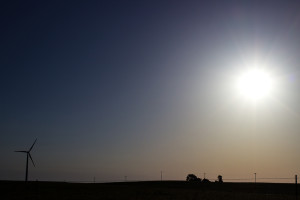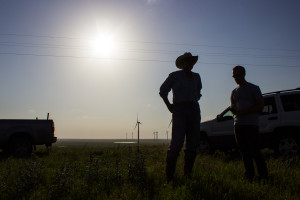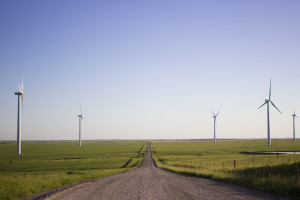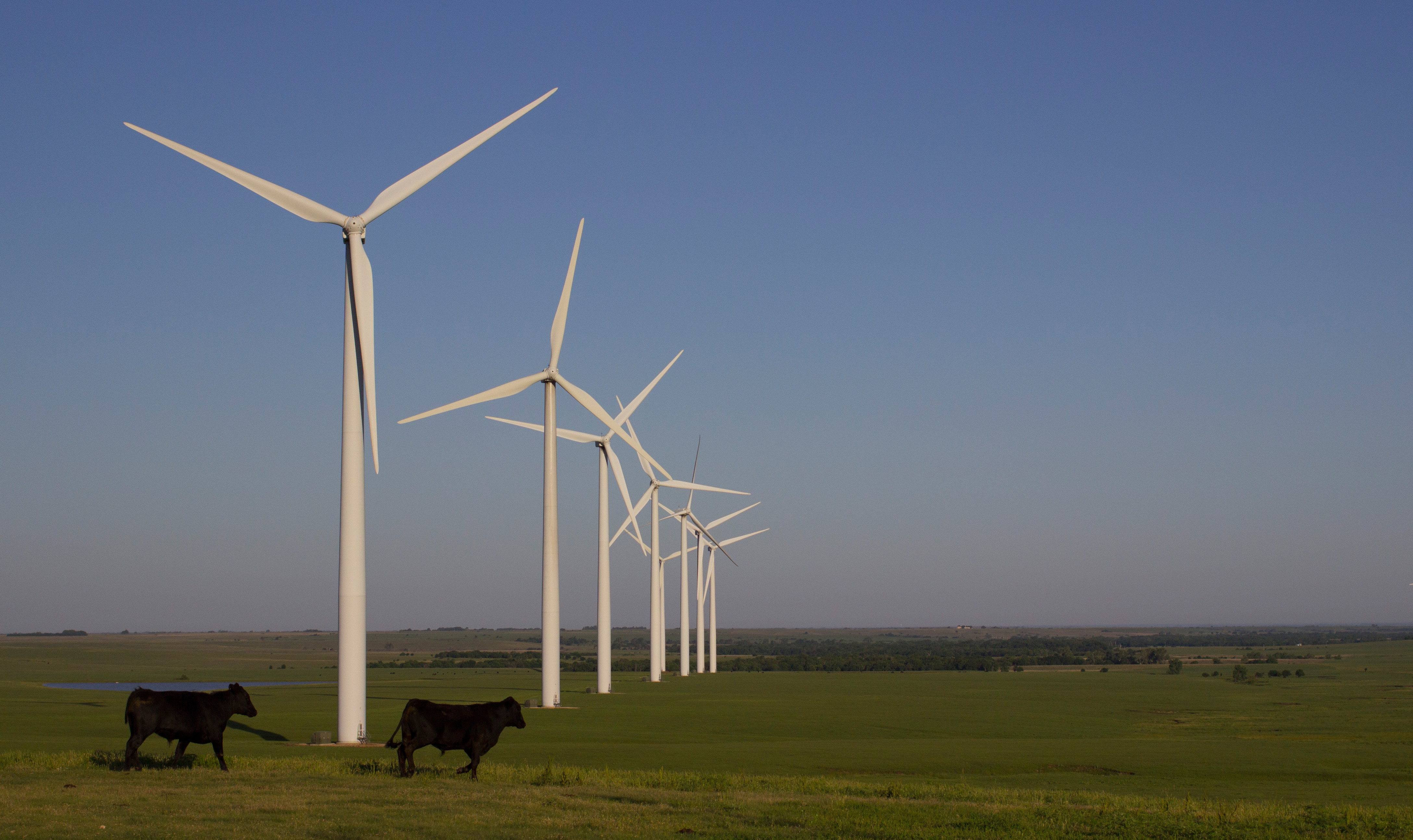Driving along Latham-Beaumont road, just south of Beaumont, Kan., pavement quickly turns to dirt, and spindly, hulking, rotating structures command attention, as they whirr in the breeze.
“They look like big, giant flowers,” said Pete Ferrell.
Ferrell, owner of the Ferrell Ranch and 4L Grazing Company in Beaumont thinks about the 100 electrical wind turbines that adorn the landscape near Beaumont.
Ferrell is the mastermind behind the Elk River Wind Project — a man that is not even in the wind energy business himself.
Instead, he is a rancher, with a profitable business of raising cattle.
Without the bountiful, rolling prairie that the Flint Hills region is known for, he said he would not be nearly as successful.
“When I go out there and get excited about something, it is because I found a new patch of Eastern Gamma grass, or Illinois Bundleflower,” Ferrell said. “So, that is what gets my juices flowing—watching the prairie flourish,”
“When we have tours of the ranch, we talk about prairie ecology,” Ferrell said.
At one point, the tallgrass prairie spanned 170 million acres across North America.
Today, that number has dwindled drastically — only 3 to 4 percent of the original prairie remains.
Most of this remaining prairie is found in the Kansas Flint Hills.
Along with being the last refuge of tallgrass prairie, the Kansas Flint Hills’ nearly constant wind has put the Flint Hills at the top of the list when it comes to a relatively new industry — wind-generated electricity.
Ferrell, did not recognize the possibilities until he found himself in Hawaii, looking for new ideas for his cattle ranch.
“At that time, the largest cattle ranch in the United States was in Hawaii, the Parker Ranch. I was at the ranch next door, working on cattle stuff, and there were turbines. They quickly explained to me, ‘we don’t have oil, coal. We have to make the best use of the resources we have.’”
After seeing the now defunct Kamaoa wind farm in 1989, Ferrell had a vision for the future of his ranch.
“Now, my eyes have been opened,” he said.
He was not the only one having that vision.
In 1994, a wind developer approached him, working with a professor from Kansas State University who had done in-depth work on creating wind maps on the state of Kansas.
“He knew more about the Ferrell Ranch than I did,” Ferrell said.
After completing extensive research of the wind patterns on the Ferrell Ranch, as well as possible side effects on the land around the ranch, plans were laid to begin construction of the of a wind farm.

By 2005, one-hundred General Electric 1.5 megawatt wind turbines, standing 262.5 feet-tall, dotted the landscape on and around the Ferrell Ranch, cementing the future of the Elk River Wind Project .
According to Iberdrola Renewables, proprietor of the Elk River Wind Project, the collection of turbines generates enough electricity to power 42,000 homes, with a projected 344,569 metric tons of carbon dioxide deflected from being produced every year.
Even with those positive attributes, the Elk River Wind Project has been unable to escape public and scientific concern.
Wind-generated electricity has been the target of some strong criticism, with some individuals questioning the use of the massive turbines that command the landscape.
“The Tallgrass prairie is a natural landscape. It also happens to be a cultural landscape,” Symphony in the Flint Hills director Christy Davis said. “One of the concerns with wind turbines and wind farms is that [they] affect that landscape, not only from a visual perspective, but also their affects on the natural landscape.”
For some, the efforts to change the composition of that landscape are inexcusable.
However, some of the main concerns by Tallgrass Prairie preservation proponents are shared with wind farm concerns elsewhere.
“The wind turbines themselves affect migratory patterns of birds, and we know that the Tallgrass Prairie attracts a good number of migratory birds,” Davis said. “Wind turbines affect that.”
Across the United States, ornithological societies have expressed concern over the impacts of wind turbines on bird populations.
The Kansas Ornithological Society is no different
Chuck Otte, member for the Kansas Ornithological Society and co-author of Birds of Kansas, explains that concerns with wind farms may be more broad than previously thought.
“The birding community has long expressed concerns because we do not know the impact of these large, commercial structures in prairie settings,” Otte said.
The Flint Hills provide not only a beautiful presentation of land and sky, it is but are also the home for many different species of animal.
One particular creature that calls the Flint Hills home is the greater prairie chicken.
Once plentiful, the existence of the greater prairie chicken is threatened due to habitat loss.
“What is the impact on prairie chickens, both greater and lesser prairie chickens?” Otte said. “The bird watcher and ornithological world has expressed a great deal of concern over wind farms and their impact on grassland nesting species.”
These concerns are not ignored by wind-generated electricity companies.
Ryan Orban, plant manager of the Elk River Wind Project, has said that the environmental concerns of others is of utmost importance.
Iberdrola Renewables has also echoed Orban’s point of environmental protection—they donate $80,000 a year to fund surveys on the prairie chicken population near the wind farm, for example.
According to Iberdrola Renewables, their efforts have made them “a wind-energy industry leader in promoting critical research needed to understand the impacts on birds and bats specific to wind turbine operations.”
The environmental impact on the prairie is something that has not been taken lightly.
“We did a bunch of studies, and the canary in the coal mine was the greater prairie chicken,” he said. “Prior to putting in the wind farm, we were very concerned about that.
Three years before construction was started, Ferrell and his team started an annual study on the prairie chickens as well.
“We continue that study today,” Ferrell said.

During the construction of the Elk River Wind Project, the altering of the prairie landscape was unavoidable — and a trend surfaced.
“Sure enough, around the time of construction, nearly all of the birds disappeared,” Ferrell said.
As time marched on, a different trend surfaced.
“As of today, however, they have come back, in larger numbers than before,” Ferrell said.
One thing that Ferrell has had to deal with as a rancher in Kansas, is the constantly changing weather, that, sometimes, ends up being severe.
The wind farm has provided one other benefit to the ranch that is more difficult to notice. Ferrell calls it “resilience.”
“Wind blows even during a drought,” Ferrell said.
One noticeable trait of the Kansas Flint Hills is the constant blowing wind, even in times of low precipitation. For a rancher like Ferrell, a drought can mean increased financial hardship, due to the increased pressure on livestock, his water supply, and feed.
For Ferrell, however, the wind farm has been a savior in dry spells on his ranch.
“2011 and 2013 were the worst droughts I have seen in my life….we ran completely out of water, I mean, zero,” Ferrell said. “I even had a full-time manager that worked in here, and I had to discharge him…if it wasn’t for the wind farm, I would have had a hard time making my financial requirements.”
After experiencing the gifts of the prairie in his own life, Ferrell has maintained a very strong commitment to making sure nothing changes in the natural makeup of the prairie.
He also believes that the the construction of the wind turbines has provided a benefit to the creatures that call Ferrell Ranch home.
“We think the turbines keep the predator birds out,” Ferrell said.
Trends in the population of the greater prairie chicken, and the lack of predators after the construction of the Elk River Wind Project, have been unavoidable.

Ferrell, however, said he has noticed something else.
“Red-tail hawks want to be 50- to 75 feet off the ground in a tree, not 262 feet on a turbine.”
Ferrell set out to make some changes—he felt he could make a difference for the prairie chickens.
“We’ve done everything we can do to change the biggest influence on the greater prairie chicken, which is our management at the surface,” he said. “I cut down every tree on the upland, I spent tens of thousands of dollars removing all perches on the upland. The trees are gone, the birds are doing well, and we have discontinued some grazing patterns that were detrimental to the birds.”
One major concern with the construction of each wind turbine is the physical damage done to the prairie earth.
“I think it is important for people to know that this is one of the most endangered landscapes on the planet,” Davis said.
The construction of the turbines does have an impact on the physical landscape. Each turbine requires a concrete pedestal 20 -foot feet across concrete pedestal to be laid almost eight 8 feet in the ground.
Each turbine is also connected to a central power station through across incredible distances of cabling, requiring trenches to be dug between each row of turbines.
Ferrell says that, due to properly executed land management, the damage can be healed completely.
“Let me ask you this: when you came in, did you see a single line of cable?” Ferrell asked. “When the turbines were originally put in, there was a massive amount of digging. Now, you can’t see any damage.”
That large concrete mounting pad at the base of each turbine?
“Mother Nature is already working on breaking apart that piece of concrete,” Ferrell said. “Believe me, she is working on it.”
One prominent concern is how turbines affect the migratory patterns of birds. In the Flint Hills, that concern looms over the land.
Christy Davis shares that concern.
“I was out at the Tallgrass National Preserve, where we saw a species of bird that we know only has 20,000 of them left, and we saw a flock of them coming through the region. There are all kinds of things we don’t even know about migratory birds…and wind turbines affect that,” Davis said.
At Elk River, Ferrell said however, things are a little different. After realizing concerns with the turbines and the bird population, he searched for an answer on whether or not the turbines cause causalities and change migratory patterns.
K-State, wanting to learn more, had biology students, hard hats on, looking around the base of each turbine for dead birds for the first three years.
“Over three years, they found nothing. Not a single bird,” Ferrell said.
After 9 nine years of the Elk River Wind Project, Ferrell has had an opportunity to reflect on his decision to introduce turbines to the highest point in the Flint Hills.
“I have absolutely no regrets,” he said. “To me, [the wind farm] is a view of a cleaner future.”
As the future of renewable energy expands, the concern involving the future of wind energy in the Flint Hills is growing as well.
Gene Young, biology professor from Northern Oklahoma College, says that some consideration needs to be done before further expansion of wind energy in Kansas.
“We need to find an area that has the best economic opportunity and the least environmental impact possible,” Young said.
Governor Sam Brownback has recognized these concerns, and has helped solidify the fate of future wind expansion in the Flint Hills for now.
A twenty-eleven statement from the Governor Brownback’s office explains the current agreement with wind energy companies that operating wind farms will be expected to finish their operating contracts. These farms will have the option to renew their contracts at the end. However, he also said that there will not be any future expansion of wind energy in the Flint Hills.
Some wonder what will happen after the 30-year power purchase agreement between Iberdrola Renewables and the Empire Electric Power company, the company that purchases the generated electricity, is finished.
Orban says that the two companies will have a discussion over the future of the project, with two paths resulting — one direction results in equipment upgrades for the farm, and the other direction results in reclamation of the land.
If a reclamation decision is made, the land must be returned to it’s original state.
Ferrell is not worried about damage to the land.
“In the span of my lifetime, trust me, the damage will go back,” he said. “Mother Nature knows best.”
—Kevin Brown/Flint Hills Media Project
(Featured image: Steers walk near wind turbines at the Elk River Wind Project near Beaumont, Kan. on June 13, 2014. (Kevin Brown/Flint Hills Media Project
